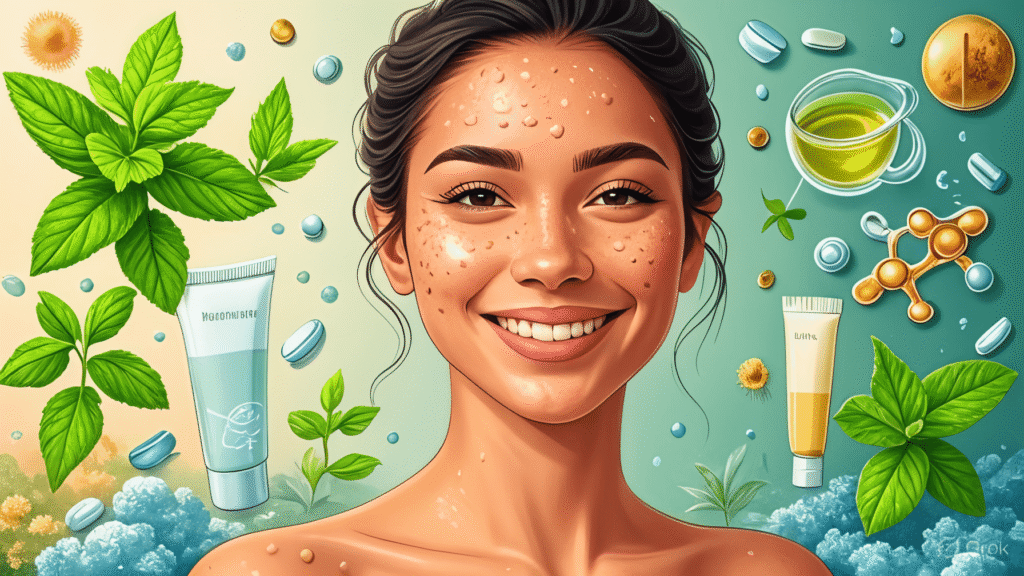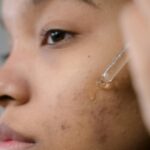Hormonal acne affects millions of adults worldwide, with studies showing that up to 50% of women in their twenties and 25% of women in their forties struggle with this persistent skin condition. Unlike teenage acne, hormonal acne in adults requires a more targeted approach that addresses the underlying hormonal imbalances while supporting the skin’s natural healing processes.
This comprehensive guide explores both evidence-based medical treatments and natural remedies that can help you achieve clearer, healthier skin by tackling hormonal acne at its root cause.
Understanding Hormonal Acne: Causes and Triggers
What Causes Hormonal Acne?
Hormonal acne occurs when fluctuations in hormone levels trigger excess sebum production, leading to clogged pores and inflammatory breakouts. The primary culprits include:
Androgens (Male Hormones):
- Testosterone increases oil production in sebaceous glands
- Dihydrotestosterone (DHT) stimulates sebum production
- DHEA-S (dehydroepiandrosterone sulfate) contributes to acne formation
Estrogen Fluctuations:
- Low estrogen levels during menstruation worsen acne
- Estrogen dominance can also trigger breakouts
- Menopause-related hormonal changes affect skin health
Key Triggers and Risk Factors
Uncontrollable Factors:
- Genetics and family history
- Menstrual cycle fluctuations
- Pregnancy and postpartum hormonal changes
- PCOS (Polycystic Ovary Syndrome)
- Thyroid disorders
Controllable Factors:
- Chronic stress and elevated cortisol levels
- Poor sleep quality and irregular sleep patterns
- High-glycemic diet and dairy consumption
- Certain skincare products and cosmetics
- Environmental toxins and pollution exposure
Traditional Medical Treatments for Hormonal Acne
Topical Retinoids
Topical retinoids remain the gold standard for acne treatment, working by normalizing skin cell turnover and reducing inflammation.
Most Effective Options:
- Tretinoin: Prescription-strength retinoid with proven efficacy
- Adapalene: Available over-the-counter, gentler than tretinoin
- Tazarotene: Strongest topical retinoid for severe cases
Application Guidelines:
- Start with pea-sized amount 2-3 times per week
- Gradually increase to nightly use as skin tolerates
- Always use sunscreen during the day
- Results typically appear after 8-12 weeks
Oral Contraceptives and Anti-Androgen Therapy
Birth Control Pills:
- Combination pills containing estrogen and progestin
- Help regulate hormonal fluctuations
- Particularly effective for women with PCOS
- May take 3-6 months to see full benefits
Spironolactone:
- Anti-androgen medication that blocks testosterone receptors
- Reduces sebum production significantly
- Typically prescribed at 50-200mg daily
- Requires regular monitoring of potassium levels
Antibiotics and Other Medical Treatments
Oral Antibiotics:
- Doxycycline and minocycline for inflammatory acne
- Usually prescribed for 3-6 months maximum
- Help reduce C. acnes bacteria and inflammation
Isotretinoin (Accutane):
- Reserved for severe, treatment-resistant cases
- Provides long-term remission in many patients
- Requires careful monitoring due to potential side effects
Natural Remedies and Supplements for Hormonal Acne
Evidence-Based Natural Treatments
Tea Tree Oil:
- Contains antimicrobial compounds that fight acne bacteria
- 5-10% concentration shows similar efficacy to benzoyl peroxide
- Apply diluted solution to affected areas twice daily
- Perform patch test before first use
Alpha Hydroxy Acids (AHAs):
- Glycolic acid and lactic acid promote cell turnover
- Help unclog pores and reduce post-inflammatory hyperpigmentation
- Start with 2-3 times per week application
- Always follow with sunscreen
Green Tea Extract:
- Rich in antioxidants and anti-inflammatory compounds
- Can be applied topically or consumed as supplement
- 2-3% topical concentration shows promising results
- Drink 2-3 cups daily for internal benefits
Vitamin and Mineral Supplementation
Vitamin D:
- Deficiency linked to increased acne severity
- Supports immune function and reduces inflammation
- Recommended dosage: 1000-4000 IU daily
- Monitor blood levels with healthcare provider
Zinc:
- Essential mineral for wound healing and immune function
- 30-40mg daily shown to reduce acne lesions
- Take with food to prevent stomach upset
- Choose zinc gluconate or zinc picolinate forms
Omega-3 Fatty Acids:
- EPA and DHA reduce inflammatory markers
- 1000-2000mg daily of combined EPA/DHA
- Choose high-quality fish oil or algae-based supplements
- Support overall skin health and hormone balance
Herbal Supplements for Hormonal Balance
Spearmint Tea:
- Anti-androgenic properties help reduce testosterone levels
- Drink 2 cups daily for 30 days to see effects
- Particularly beneficial for women with PCOS
- Generally safe with minimal side effects
Saw Palmetto:
- Blocks 5-alpha reductase enzyme that converts testosterone to DHT
- 160-320mg daily of standardized extract
- May take 2-3 months to show results
- Consult healthcare provider before use
Chaste Tree (Vitex):
- Helps balance progesterone and estrogen levels
- 400-1000mg daily of standardized extract
- Best taken consistently for 3-6 months
- May interact with hormonal medications
The Gut-Skin Axis: Addressing Internal Health
Microbiome Connection to Hormonal Acne
Recent research reveals a strong connection between gut health and skin conditions. An imbalanced gut microbiome can:
- Increase systemic inflammation
- Affect hormone metabolism
- Compromise immune function
- Influence nutrient absorption
Supporting Gut Health:
- Include fermented foods like kefir, sauerkraut, and kimchi
- Take a high-quality probiotic supplement (10-50 billion CFUs)
- Consume prebiotic fiber from vegetables and fruits
- Avoid processed foods and artificial additives
Liver Support for Hormone Detoxification
The liver plays a crucial role in metabolizing and eliminating excess hormones:
Natural Liver Support:
- Milk thistle (200-400mg daily)
- Dandelion root tea (2-3 cups daily)
- Cruciferous vegetables (broccoli, kale, Brussels sprouts)
- Adequate hydration (8-10 glasses water daily)
Diet and Lifestyle Modifications
Foods to Avoid for Clearer Skin
High-Glycemic Foods:
- White bread, pasta, and refined cereals
- Sugary snacks and beverages
- Processed foods with added sugars
- White rice and instant oatmeal
Dairy Products:
- Milk contains hormones that may trigger acne
- Whey protein supplements can worsen breakouts
- Consider plant-based alternatives like almond or oat milk
Anti-Inflammatory Foods to Include
Skin-Supporting Nutrients:
- Colorful vegetables rich in antioxidants
- Wild-caught fish high in omega-3s
- Nuts and seeds for healthy fats
- Green leafy vegetables for folate and minerals
- Berries for vitamin C and antioxidants
Stress Management Techniques
Chronic stress elevates cortisol levels, which can worsen hormonal acne:
Effective Stress Reduction Methods:
- Regular meditation or mindfulness practice
- Yoga or gentle stretching exercises
- Deep breathing techniques
- Adequate sleep (7-9 hours nightly)
- Regular physical activity
- Journaling or creative outlets
Environmental Factors and Skincare Routine
Ingredients to Avoid
Pore-Clogging Ingredients:
- Coconut oil and other comedogenic oils
- Heavy silicones and waxes
- Artificial fragrances and dyes
- Harsh sulfates and alcohol-based toners
Building an Effective Skincare Routine
Morning Routine:
- Gentle cleanser with salicylic acid or tea tree oil
- Vitamin C serum for antioxidant protection
- Lightweight, non-comedogenic moisturizer
- Broad-spectrum SPF 30+ sunscreen
Evening Routine:
- Double cleanse to remove makeup and impurities
- Topical retinoid or natural alternative
- Hydrating serum with hyaluronic acid
- Nourishing night moisturizer
Treatment Timeline and Expectations
What to Expect During Treatment
Weeks 1-4:
- Initial adjustment period with possible temporary worsening
- Skin may feel dry or irritated with new treatments
- Focus on gentle, consistent routine
Weeks 4-8:
- Gradual improvement in skin texture
- Reduced frequency of new breakouts
- Less inflammation and redness
Weeks 8-16:
- Significant improvement in overall skin appearance
- Fewer active lesions and faster healing
- Improved skin tone and reduced scarring
Monitoring Progress
Keep a skin diary tracking:
- Daily skincare routine and products used
- Dietary changes and supplement intake
- Menstrual cycle and hormonal fluctuations
- Stress levels and sleep quality
- Progress photos taken weekly
When to Seek Professional Help
Consult a dermatologist or healthcare provider if:
- Acne is severe or cystic in nature
- Over-the-counter treatments haven’t worked after 12 weeks
- Scarring is developing
- Acne is affecting mental health and self-esteem
- Irregular menstrual cycles accompany acne
- Signs of hormonal disorders are present
Frequently Asked Questions
Q: How long does it take to see results from natural remedies?
A: Natural treatments typically require 8-12 weeks of consistent use to show significant improvement. Some people may notice changes sooner, while others need up to 16 weeks for optimal results.
Q: Can I combine natural remedies with prescription treatments?
A: Yes, many natural approaches complement medical treatments well. However, always consult your healthcare provider before combining treatments to avoid interactions or over-treatment.
Q: Is hormonal acne only a problem for women?
A: While more common in women due to menstrual cycles and hormonal fluctuations, men can also experience hormonal acne, particularly during puberty or due to stress and lifestyle factors.
Q: Will my hormonal acne come back after treatment?
A: Hormonal acne may return if underlying hormonal imbalances aren’t addressed. Maintaining a consistent skincare routine, healthy lifestyle, and managing stress can help prevent recurrence.
Q: Are natural remedies as effective as prescription medications?
A: Natural remedies can be very effective, especially for mild to moderate hormonal acne. However, severe cases may require prescription treatments for optimal results. Many people find success combining both approaches.
Take Action for Clearer Skin
Achieving clear skin from hormonal acne requires a comprehensive approach that addresses both internal and external factors. Start by implementing one or two changes at a time, whether it’s adjusting your diet, adding targeted supplements, or refining your skincare routine.
Remember that consistency is key – give any new treatment at least 8-12 weeks to show results. Consider working with a healthcare provider or dermatologist to develop a personalized treatment plan that combines the most effective conventional and natural approaches for your specific needs.
Your journey to clearer, healthier skin starts with understanding your unique triggers and choosing treatments that support your body’s natural healing processes. With patience and the right approach, you can successfully manage hormonal acne and achieve the confident, radiant skin you deserve.



